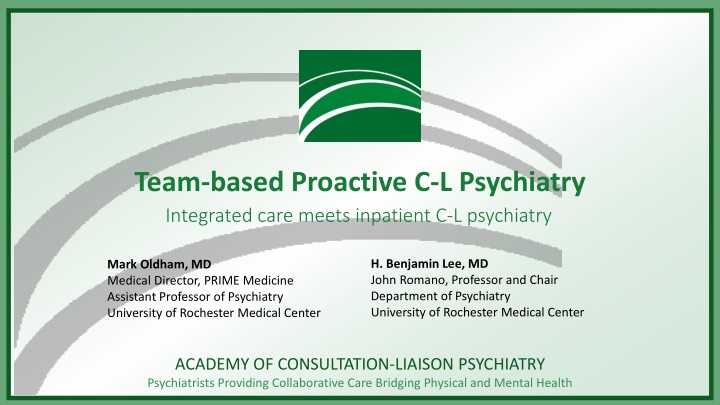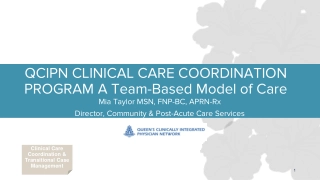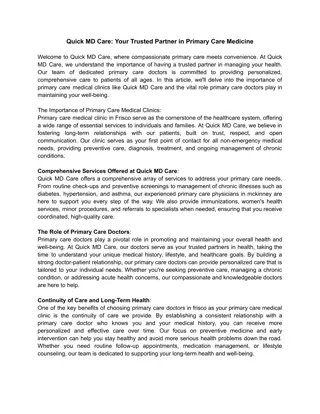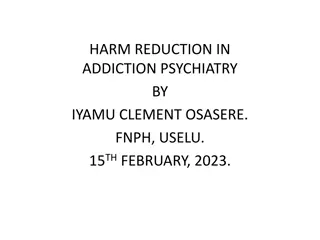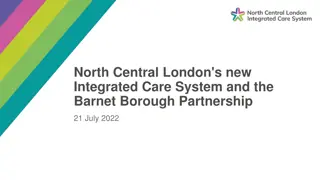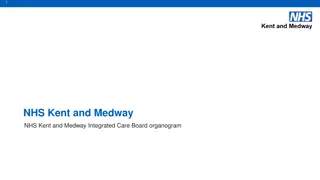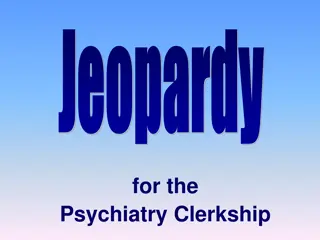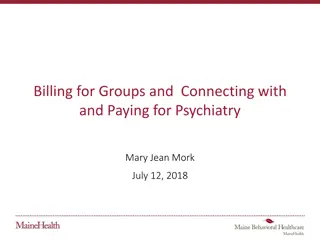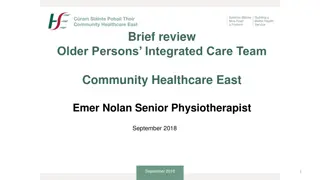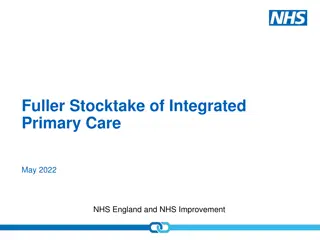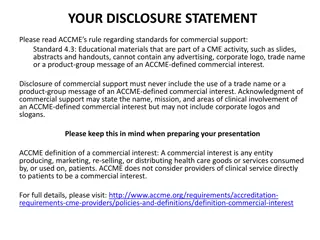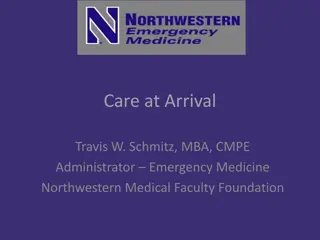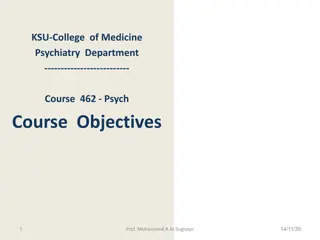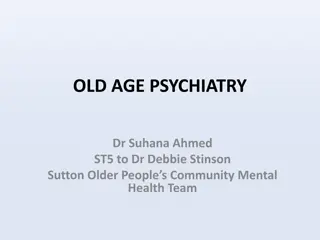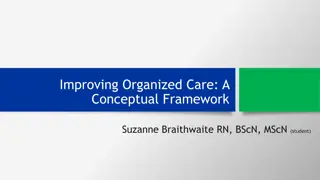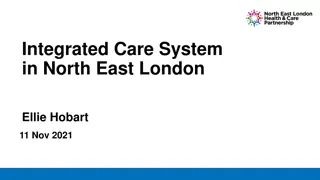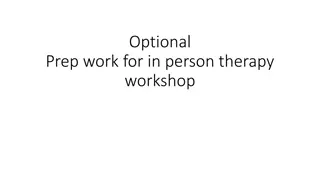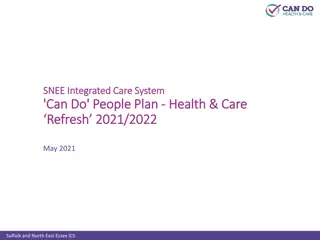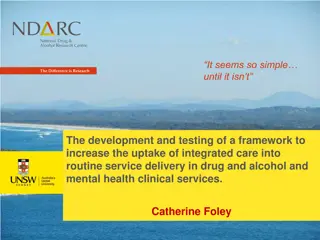Team-based Proactive C-L Psychiatry Integrated Care
An interdisciplinary model of C-L psychiatry incorporating systematic screening for mental health conditions, early clinical intervention, and integration with primary teams. Goals include facilitating efficient care, improving outcomes, and operating based on the principles of proactive C-L. The staggering cost of mental illness is highlighted, showcasing the significant impact on disability and mortality rates. Rethinking C-L psychiatry through a proactive, modern approach for future horizons in value-based care.
Download Presentation

Please find below an Image/Link to download the presentation.
The content on the website is provided AS IS for your information and personal use only. It may not be sold, licensed, or shared on other websites without obtaining consent from the author.If you encounter any issues during the download, it is possible that the publisher has removed the file from their server.
You are allowed to download the files provided on this website for personal or commercial use, subject to the condition that they are used lawfully. All files are the property of their respective owners.
The content on the website is provided AS IS for your information and personal use only. It may not be sold, licensed, or shared on other websites without obtaining consent from the author.
E N D
Presentation Transcript
Team-based Proactive C-L Psychiatry Integrated care meets inpatient C-L psychiatry H. Benjamin Lee, MD John Romano, Professor and Chair Department of Psychiatry University of Rochester Medical Center Mark Oldham, MD Medical Director, PRIME Medicine Assistant Professor of Psychiatry University of Rochester Medical Center ACADEMY OF CONSULTATION-LIAISON PSYCHIATRY Psychiatrists Providing Collaborative Care Bridging Physical and Mental Health
Disclosures With respect to the following presentation, there has been no relevant (direct or indirect) financial relationship between the party listed above (and/or spouse/partner) and any for-profit company which could be considered a conflict of interest. Academy of Consultation-Liaison Psychiatry
What is proactive C-L psychiatry? An interdisciplinary model of C-L psychiatry that incorporates Systematic screening for mental health conditions, Early clinical intervention, and Integration with primary teams. What are the goals of proactive C-L psychiatry? To facilitate efficient careand Improve outcomes In a cost-effective manner. Academy of Consultation-Liaison Psychiatry
Unmet needs rethinking C-L psychiatry Proactive C-L a modern approach Daily operations the principles of proactive C-L in action Future horizons C-L psychiatry for value-based care Academy of Consultation-Liaison Psychiatry
The staggering cost of mental illness Accounts for 1/3 of all years lived with disability1,2 5 of the top 20 causes of disability in high-income countries Disproportionately affects working-aged adults Contributes to leading causes of death3 Heart disease, cancer, and cerebrovascular disease Suicide itself is the 10th leading cause of death Associated with 2x RR of all-cause mortality4 Meta-analysis from 29 countries across 6 continents Can shave a decade or more off life4,5 Mental illness: 10 years of life lost Substance use: 25 years of life lost Dual diagnosis: 30 years of life lost Academy of Consultation-Liaison Psychiatry 1Vigo Lancet Psychiatry 2016; 2Whiteford Lancet 2013; 3www.cdc.gov; 4Walker JAMA Psychiatry 2015; 5Oregon DHS 2008
The cost of mental illness in the general medical hospital1-3 Hospital costs Longer LOS: UC, Davis Medical Center, annual cost est. $11M1 Constant companion & restraint use Poorer health outcomes/readmissions Denied days due to delay in psychiatric disposition Staff costs Lack of training, stigma and implicit bias Dissatisfaction & distress Spill-over effect to other patients Patient costs Compromised quality of care Mistrust may lead patients to avoid future medical care Academy of Consultation-Liaison Psychiatry 1Bourgeois Psychosom 2005; 2Desan Psychsom 2011; 3Sledge Psychoth Psychosom 2015
Psychiatric comorbidity in medical inpatients Medical Inpatients Psychiatric comorbidity1,2 Lengthens hospitalizations Increases risk of re-hospitalization Increases healthcare costs Est $11M/yr at UC Davis3 40% 60% Academy of Consultation-Liaison Psychiatry 1Jansen PLOS ONE 2018; 2Hansen 2001; 3Bourgeois Psychosomatics 2005
Psychiatric conditions can compromise care in myriad ways Condition Selected maladaptive features Delirium Agitation, restlessness, confusion Dementia Forgetfulness, sundowning, care refusal Personality change due to TBI Emotional lability, impulsivity Developmental disorder Nonverbal, oppositional, defiant Eating disorder Hiding food, manipulating weigh-ins Substance use disorder Exaggerating CIWAs, contraband Psychotic disorder Paranoia, cheeking medications Anxiety disorder Refusing workup, overuse of call button Mood disorders Suicidal, disruptive mania Personality disorder Demanding, hostile, splitting Munchausen syndrome Self-injury, deception Academy of Consultation-Liaison Psychiatry
Unmet needs rethinking C-L psychiatry Proactive C-L a modern approach Daily operations the principles of proactive C-L in action Future horizons C-L psychiatry for value-based care Academy of Consultation-Liaison Psychiatry
Early pilot study: Proactive psychiatric consultation A-B-A study embedding a psychiatrist in an internal medicine service Consult rates A = 11% B = 23% Findings Half of patients with mental illness LOS reduced among intervention sample (2.9 d vs 3.8 d) Lower proportion LOS 4 d (15% vs 28%) Conclusion High burden of prevalent psychiatric illness Under-utilization of psychiatric services Academy of Consultation-Liaison Psychiatry
Next step: A multi-disciplinary team approach Pre post study on 3 medicine units (92 beds) Team members Half-time psychiatrist Nurse (clinical nurse specialist; later an APRN) Social worker We found reduced lengths of stay Patients with psychiatric consult: 0.65 d (7.3 vs. 6.7 d) Overall reduction: 0.29 d (5.9d vs 5.6 d) Academy of Consultation-Liaison Psychiatry
Cost-benefit analysis: Proactive vs traditional C-L psychiatry Cost-benefit: 11 mos, assuming 3.3% inflation 1. Average direct cost per case Includes room/board, labs, imaging, Rx, etc. (using AllscriptsTM) $6760 ?? $6550 ??? = $210 ??? ???? ? 509 ??? ????? = $???? 2. Backfill (assuming 100% occupancy) ??? ?????????=0.65 ? 509 ??? ????? ??? ??? = 5.8 57 ???????? ? ??? ??????? ??? ???? = $12,700 = $???? = ?? ?????????? ???????? Academy of Consultation-Liaison Psychiatry Sledge et al. Health Econ & Outcome Res 2016.
Cost-benefit analysis: Proactive vs traditional C-L psychiatry Gross savings: Minus costs: Net gain: Annualized: per case ????? = $107? + ???????? = $724? = $???? (?????,??,part time MD salary + benefits) = $306 $306k k ??? ???? ??????? = $???? $???,??? Academy of Consultation-Liaison Psychiatry Sledge et al. Health Econ & Outcome Res 2016.
Proactive models whose screening was guided by clinical expertise in mental health care and care delivery was integrated with primary services were associated with reduced LOS1 Found favorable returns on investment that more than offset the increased costs of providing this level of enhanced care. 1 3 Academy of Consultation-Liaison Psychiatry 1Oldham Gen Hosp Psychiatry 2019; 2Desan Psychosom 2011; 3Sledge Health Econ Out Res 2016
Differences between traditional C-L and proactive C-L Characteristic Traditional C-L Proactive C-L Service delivery Reactive (often to crises) Proactive Personnel Single discipline Multidisciplinary Case identification Primary team orders a consultation Screening-driven Enriched by nursing interactions Mode of intervention Recommendations to primary team Collaboration with patients treatment team (providers, nurses, social work) Service goals Treatment recommendation Risk reduction Crisis management Preventing behavioral barriers to care Crisis prevention Location Across the hospital (typically) Dedicated hospital units or services Academy of Consultation-Liaison Psychiatry
The principles of proactive C-L Proactive C-L Traditional C-L Many psychiatric needs unidentified Population approach Systematic screening Mental health care crisis-focused Prevention mindset Proactive care Recs chiefly for providers Multidisciplinary approach Team-work Collaborative care delivery Liaison role variable Integrated care Academy of Consultation-Liaison Psychiatry
Unmet needs rethinking C-L psychiatry Proactive C-L a modern approach Daily operations the principles of proactive C-L in action Future horizons C-L psychiatry for value-based care Academy of Consultation-Liaison Psychiatry
1. Population approach: systematic screening Goal: to identify patients for whom early psychiatric intervention is likely to preempt crises, clinical deterioration, or compromised care. Systematic: reviewing every patient on certain hospital units or services Standardized: using a consistent, reproducible strategy As early as feasible: prompt screening to prevent a cascade of complications Sliding threshold: adaptable interventions based on patient volume Step-wise: may be done in one step (e.g., positive/negative on chart review) or multi- step (e.g., screening those positive on chart review with nursing/primary team) Human vs machine: can be by hand or automated (e.g., a report that can be generated as needed), though electronic medical records often need to be optimized Academy of Consultation-Liaison Psychiatry
2. Prevention mindset: Proactive care Tailored degree of involvement: interventions can be carried out by any number of proactive CL team members. Curbsides: targeted recommendations w/o formal consultation often adequate Care/behavioral plans: develop plans to address maladaptive interactions between patients and staff, care-compromising behaviors, or non-adherence Nurse interventions: provide personalized recommendations for nurses to treat patients (e.g., delirium precautions, poor sleep hygiene) Psychiatric disposition: prompt facilitation of disposition if psychiatric needs are anticipated (e.g., psychiatric admission, partial hospitalization) Aftercare planning: ensuring adequate aftercare supports, community resources, and mental health referrals Academy of Consultation-Liaison Psychiatry 19
3. Multidisciplinary approach: Teamwork C-L psychiatrist Director/supervision Consultation Legal documents Social worker Screening Community resources Aftercare/disposition Nurse practitioner Coordinator/triage Consultation Screening Potential team members Clinical nurse specialist RN coordinator Patient service manager Health psychologist Trainees Academy of Consultation-Liaison Psychiatry
4. Integrated care: Collaborative care delivery Corresponding expertise: physician to physician; NP to NP/RN; SW to SW/care coordinator Aligning workflow: psychiatric care tailored to medicine & nursing workflow on dedicated units/services Flexible intensity: not all patients Real-time communication: the effect of which supports efficiency and develops healthy relationships, bidirectional education, and mutual trust Academy of Consultation-Liaison Psychiatry 21
Common steps in performing a screen Psychiatric comorbidity? Screen charts of admitted patients each morning. 1 Behavioral concerns? Academy of Consultation-Liaison Psychiatry
Common steps in performing a screen Any active issue(s)? Inquire about behavioral concerns from RN. 2 At baseline? Psychiatric comorbidity? Screen charts of admitted patients each morning. 1 Behavioral concerns? Academy of Consultation-Liaison Psychiatry
Common steps in performing a screen 1. No changes in care 2. Curbside/targeted rec Discuss potential concerns with medical team 3. Psychiatric consultation Wellness plan 3 Any active issue(s)? Inquire about behavioral concerns from RN. 2 At baseline? Psychiatric comorbidity? Screen charts of admitted patients each morning. 1 Behavioral concerns? Academy of Consultation-Liaison Psychiatry
Notes about daily workflow Before rounds screening Psychiatric rounds often runs similar to traditional C-L rounds Care delivery Interdisciplinary, nursing care, primary team rounds Prioritize patients for care efficiency (e.g. care-compromising behaviors) Consultations performed (often with SW) Ongoing, real-time conversations with teams Cuts down dramatically on the discharge dependent consult Afternoons often provide opportunities for educational investment Academy of Consultation-Liaison Psychiatry
Unmet needs rethinking C-L psychiatry Proactive C-L a modern approach Daily operations the principles of proactive C-L in action Future horizons C-L psychiatry for value-based care Academy of Consultation-Liaison Psychiatry
Future horizons for proactive C-L The field awaits the results of randomized trials of proactive C-L The UK HOME Study1 Expansion to additional settings with higher costs per patient Critical care Oncology Surgery Further development within value-based care Focus on vertical integration Single-payer systems (e.g., VA) Academy of Consultation-Liaison Psychiatry 27 1Walker et al. The HOME Study. Trials. 2019.
Outcomes of interest to be explored further Financial impact beyond reduced length of stay Cost of sitters & security Cost of nursing turnover Re-admission rates Enhanced RVU Satisfaction: providers, nurses, patients, families Medical staff burnout Medical staff performance Patient symptoms, functioning, and outcomes Care quality: injuries (patients & staff) and falls Handoff to outpatient providers (vertical integration) Academy of Consultation-Liaison Psychiatry 28
Questions remain Which elements of proactive C-L are required for which benefits? Are there more effective ways of operationalizing the four principles of proactive C-L? Which patient-specific factors (e.g., age, population) and hospital contexts (e.g., critical care, surgery) might experience differential benefits from different ways of delivering proactive C-L? What factors are associated with successful implementation and delivery of proactive C-L models? Academy of Consultation-Liaison Psychiatry 29
The ACLP Proactive C-L Special Interest Group (SIG) Join the growing community of providers practicing proactive C-L psychiatry The Proactive C-L SIG offers an active Listserv to learn from others in the community Obtain peer consultations while pursuing proactive C-L Visit the Proactive C-L SIG website (www.clpsychiatry.org/sigs/proactive-cl-sig/) The Proactive C-L SIG Resource Center offers ( /proactive-cl-sig-resources/) An overview of Proactive C-L Psychiatry Curated materials from sites with Proactive C-L services An updated bibliography on Proactive C-L A review of previous ACLP presentations (symposia, workshops, etc.) Academy of Consultation-Liaison Psychiatry 30
Unmet needs rethinking C-L psychiatry Proactive C-L a modern approach Daily operations the principles of proactive C-L in action Future horizons C-L psychiatry for value-based care Academy of Consultation-Liaison Psychiatry
Team-based Proactive C-L Psychiatry Integrated care meets inpatient C-L psychiatry H. Benjamin Lee, MD John Romano, Professor and Chair Department of Psychiatry University of Rochester Medical Center Mark Oldham, MD Medical Director, PRIME Medicine Assistant Professor of Psychiatry University of Rochester Medical Center ACADEMY OF CONSULTATION-LIAISON PSYCHIATRY Psychiatrists Providing Collaborative Care Bridging Physical and Mental Health
